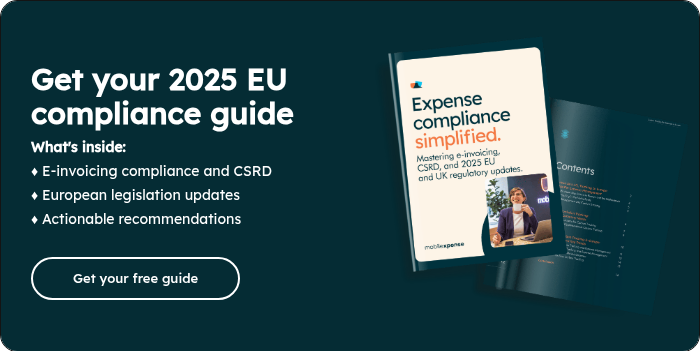VAT 2025: Current VAT Rates and German Examples
VAT is an integral part of everyday business life. Whether purchasing goods, booking services or issuing invoices, companies must calculate, report and pay VAT correctly.
But what changed in 2025?
The good news is that VAT rates in Germany will remain stable.
In this article, you will find out which products and services are subject to VAT, which rates apply in 2025 and what companies need to bear in mind for correct accounting.
VAT rates in Germany will remain stable in 2025:
- 19% (standard rate)
- 7% (reduced tax rate)
- 0 % (tax-free)
The e-invoicing obligation for B2B transactions is new: From 2025, companies must issue invoices in a structured electronic format.
With an AI-supported document scanner (OCR) such as in the Mobilexpense app, VAT rates can be recognised automatically, documents can be archived in compliance with GoBD and errors in accounting can be avoided. This keeps your tax processes efficient, correct and future-proof.
What does VAT mean?
The abbreviation VAT stands for value-added tax. VAT is a so-called consumer tax (consumption tax) that is levied on the end consumer when purchasing products or services.
Companies add VAT to the net amount of their goods and services and receive it from their customers via the gross sales price. The VAT received must then be paid to the tax office.
Value-added tax vs. sales tax?
Sales tax is often referred to in general terms. Sales tax is the generic term for VAT and input tax, as most sales in national and international trade are taxed.

VAT rates 2025 in Germany
VAT will remain unchanged in 2025. In Germany, the standard VAT rate is currently 19%. The reduced tax rate of 7% is applied to products for basic needs. Some products and services, on the other hand, are exempt from VAT. All companies, tax authorities and courts are bound by the VAT Act.
Below you can see the current VAT rates for Germany.
- 19% value added tax (standard rate)
- 7 % VAT (reduced tax rate)
- 0 % VAT (VAT-free)
Standard tax rate (19%)
According to Section 12 (1) UStG, the standard VAT rate applies to all sales to which none of the other VAT rates apply. Examples of this are clothing (fashion), furniture, services and catering in a restaurant/café.
Reduced tax rate (7%)
According to Section 12 (2) UStG, the reduced VAT rate of 7% applies to food, books and magazines, local public transport, tickets for concerts, theatres or museums and live animals, among other things.
The complete list of transactions to which the reduced VAT rate of 7% applies and the conditions can be found in Section 12 (2) UStG.
VAT-exempt transactions (0% VAT)
Numerous deliveries and services are tax-exempt in accordance with the VAT Act. All VAT-exempt services are listed in Section 4 of the UStG.
For example, medical services are exempt from VAT. Intra-Community deliveries are also covered by this paragraph (note exceptions). Certain transactions that serve the common good are also exempt from VAT.
Who is liable for VAT?
According to § 1 Para. 1 No. 1 UStG, all sales from deliveries and services that a company carries out in Germany in return for payment are subject to VAT.
Who is exempt from VAT?
Some professional groups and transactions are exempt from VAT, including
- Doctors and health professionals: Medical treatments are not subject to VAT.
- Educational offers: School and university tuition as well as recognised further education courses are tax-free.
- Insurance and financial services: Insurance premiums and certain banking services are exempt from VAT.
Small Business Regulation 2025
The small business regulation enables companies with low turnover to remain exempt from VAT. From 2025, the turnover limit will be increased to €25,000 per year (previously €22,000). Companies that do not exceed this limit do not have to declare VAT, but are also not allowed to claim input tax.
The rules on the taxation of small businesses can be found in Section 19 of the UStG.
Changes in 2025: Introduction of the e-invoicing obligation
Although the tax rates remain the same, there is one significant change: from 2025, electronic invoicing (e-invoicing) will be mandatory for B2B transactions. Companies must issue their invoices in a structured electronic format. This regulation is intended to drive digitalisation and reduce sources of error in accounting.
Book value added tax correctly
Companies must calculate and post VAT correctly. The most important points:
- Invoices must show the correct VAT rate.
- The VAT received must be regularly reported to the tax office and paid.
- Input tax can only be claimed if a proper invoice is available.
- Accounting should be documented in an audit-proof manner.
Common VAT mistakes - and how to avoid them
Even though VAT is one of the best-known types of tax, mistakes are often made in practice. These can not only lead to unnecessary additional expenses, but in the worst case, to additional payments or fines.
Typical sources of error in companies:
- Incorrect tax rate: the reduced rate of 7% is often applied to products that are actually subject to the standard tax rate of 19% - or vice versa.
- Incomplete invoice details: A missing tax number or VAT identification number can jeopardise the input tax deduction.
- Foreign sales booked incorrectly: Particularly in the case of intra-Community supplies and services, the correct details are crucial to correctly document tax-free sales.
- Missing or incorrect receipts: Without a proper invoice, no input tax can be claimed.
- Manual input errors: transposed figures or incorrect amounts when entering into the accounting system quickly lead to differences.
Tip: An AI-powered receipt scanner (OCR) automatically reads line items and key data (VAT rate, net/gross amount, VAT amount, VAT ID, date) and identifies the correct VAT rate based on the type of expense and legal context. This saves you time, avoids corrections, and ensures accurate tax accounting.
Legal regulation on value-added tax
The information and examples given in this article are for guidance only. The law contains numerous rules, special features and exceptions that are not the subject of this article.
In order to always act correctly and apply the correct VAT rate, there is the VAT Act and a binding legal ordinance for all entrepreneurs. In addition to the aforementioned VAT Act, there is also the VAT Implementation Ordinance (UStDV).
Here, entrepreneurs can find detailed information on the tax treatment of deliveries and services. The UStDV is a legal regulation that ensures uniform application of the law and jurisdiction by the tax authorities. If you have any questions about VAT, please consult your tax advisor.

Conclusion: Stable tax rate, new requirements and opportunities for automation
Although VAT will remain unchanged in 2025, the introduction of mandatory e-invoicing marks an important step towards digital accounting. Companies should use this opportunity to modernise their processes and automate tax procedures.
Those who record expenses digitally, automatically allocate VAT and archive receipts in an audit-proof manner not only save time but also reduce the risk of errors and queries from tax authorities.
Mobilexpense helps you to record all expenses efficiently and in compliance with GoBD. Thanks to automatic VAT recognition, digital receipt management and interfaces that can be integrated with your accounting software, you can keep track of all tax-relevant expenses at all times - transparently, securely and in a time-saving manner.
Share this
You might also be interested in these articles
/Listing%20Images/Higher%20Tax-Free%20Mileage%20Allowance%20From%202023%20in%20the%20Netherlands%20%E2%80%93%201.png)
Best Expense Management Solutions for the Netherlands
.png)
Best Expense Management Solution for the United Kingdom
/Listing%20Images/Internationale%20Rechnung%20erstellen%20listing.png)
Expense Management Trends for 2026: The Rise of Automation and AI in Expenses
/Listing%20Images/Updated%20VAT%2c%20Mileage%20and%20Allowance%20Rates%20for%202024%20%E2%80%93%201.png)


